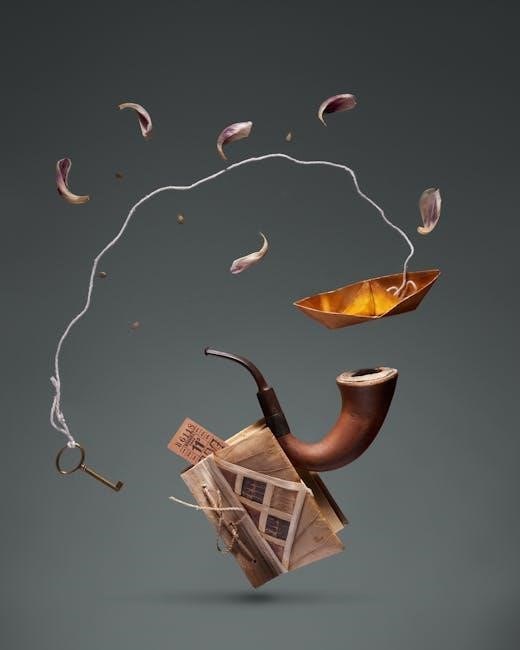The Greater Key of Solomon is a foundational grimoire in Western occult tradition, attributed to King Solomon. It contains detailed rituals, pentacles, and prayers for magical operations.
1.1 Brief Overview of the Text
The Greater Key of Solomon is a renowned grimoire attributed to King Solomon, offering a comprehensive guide to magical practices. It includes detailed rituals, prayers, and the use of pentacles to invoke spiritual entities and achieve specific goals. The text emphasizes ceremonial magic, requiring precise gestures and incantations for effective outcomes. Historically, it was first widely published in the 17th century and has since become a cornerstone of Western occultism. Its influence extends beyond magic, shaping spiritual and philosophical thought. Despite its age, the grimoire remains a subject of study and practice, captivating those interested in occult traditions and ritualistic arts.
1.2 Historical Background and Authorship
The Greater Key of Solomon is attributed to King Solomon, though its true authorship remains uncertain. It is classified as a pseudepigrapha, meaning it was likely written by later followers who sought to associate their work with Solomon’s wisdom. Scholars believe the text was compiled by multiple anonymous authors over centuries, blending Jewish mysticism, Christian influences, and medieval European occult practices. The grimoire gained prominence after its publication in the 17th century, with notable editions like the 1916 version by L.W. DeLaurence. Despite debates over its authenticity, it remains a cornerstone of Western magical traditions, shaping Solomonic magic and influencing modern occultism.
The Greater Key of Solomon is structured into detailed chapters, covering magical operations, rituals, and the creation of pentacles. Its content emphasizes ceremonial practices and divine invocations.
2.1 Chapters and Sections
The Greater Key of Solomon is divided into comprehensive chapters, each addressing specific aspects of magical practice. These sections include detailed rituals for consecration, invocation, and divination, alongside instructions for crafting magical tools and pentacles. The grimoire also contains elaborate diagrams and explanations for constructing ceremonial equipment, such as the Circle of Solomon, which is central to its rituals. Each chapter is designed to guide practitioners through complex magical operations, emphasizing the importance of precise preparation and adherence to sacred protocols. The text is structured to progressively build upon foundational principles, ensuring a systematic approach to mastering its arcane teachings.

Structure and Content of the Grimoire
2.2 Key Magical Operations and Rituals
The Greater Key of Solomon outlines a wide array of magical operations, including rituals for invocation, evocation, and consecration. Central to these practices are elaborate ceremonies requiring precise preparation, such as the creation of the Circle of Solomon, a protective barrier for the magician. The grimoire details rituals for summoning and controlling spirits, emphasizing the use of divine names, prayers, and pentacles to establish authority. It also includes operations for divination, healing, and protection, each with specific instructions for timing, tools, and chants. These rituals are structured to align the practitioner with celestial forces, ensuring harmony and efficacy in their magical endeavors.
Key Components of the Greater Key of Solomon
The grimoire emphasizes pentacles, prayers, and specific rituals, detailing their significance in aligning the practitioner with celestial forces and ensuring magical efficacy and protection.
3.1 Pentacles and Their Significance
The Greater Key of Solomon places great emphasis on pentacles, which are intricate magical tools central to its rituals. These symbols are crafted on metal or parchment, often featuring divine names and celestial seals. They serve as focal points for summoning and controlling spirits, ensuring the magician’s authority and protection. Each pentacle is associated with specific celestial entities and is designed to manifest particular outcomes, such as protection, healing, or divination; The text meticulously details their construction, emphasizing the importance of purity and alignment with divine will. Properly consecrated, pentacles act as conduits for celestial power, embodying the essence of Solomonic magic.
3.2 Prayers, Invocations, and Divine Names
The Greater Key of Solomon is rich in prayers and invocations, which are essential for establishing a divine connection. These sacred formulas often incorporate Hebrew and Latin names of God, such as “Elohim” and “Adonay,” to invoke divine authority. The prayers are structured to align the magician with celestial powers, ensuring rituals are performed with humility and reverence. Invocations serve to summon specific spirits, while divine names amplify the magician’s intent. Proper recitation is stressed to maintain efficacy and safety, reflecting the text’s emphasis on the fusion of devotion and magical practice. These elements underscore the grimoire’s dual role as a spiritual and magical guide.
3.3 Rituals and Ceremonial Magic Practices
The Greater Key of Solomon details elaborate rituals and ceremonial practices, emphasizing precise gestures, incantations, and preparations. These rituals are designed to align the practitioner with divine and celestial forces, ensuring magical operations are conducted with authority and safety. The text stresses the importance of purification, consecration, and the proper use of magical tools, such as wands, swords, and pentacles. Ceremonial magic within the grimoire often involves complex sequences of prayers, invocations, and offerings to invoke specific spirits or achieve desired outcomes. The rituals are structured to reflect a deep reverence for divine power, blending devotional practices with practical magical techniques. This blend underscores the grimoire’s significance in Western occult traditions.

Historical Significance and Influence
The Greater Key of Solomon holds immense historical significance as a foundational text in Western occultism, influencing countless magical traditions and shaping modern ceremonial practices.
4.1 Impact on Occultism and Western Magic
The Greater Key of Solomon has profoundly shaped Western occultism, becoming a cornerstone of ceremonial magic. Its detailed rituals, pentacles, and invocations have influenced countless practitioners, inspiring movements like the Golden Dawn. The grimoire’s emphasis on divine authority and structured magical processes has made it a foundational text for modern occult practices. Its principles have been adapted and integrated into various traditions, ensuring its relevance across centuries. The text’s influence extends beyond magic, impacting literary and philosophical works. As a result, it remains a vital resource for understanding and practicing Western esoteric traditions, bridging ancient wisdom with contemporary magical practices.
4.2 Evolution of the Text Over Time
The Greater Key of Solomon has undergone significant transformations since its origins. Initially attributed to King Solomon, the text was likely compiled by later occultists, blending diverse magical traditions. Over centuries, it evolved through translations and adaptations, with various manuscripts surfacing in different languages. The grimoire gained prominence in the 20th century with its first widely available publication in 1916 by L.W. DeLaurence. This edition introduced the text to modern occultism, sparking widespread interest and reinterpretation. Despite its evolution, the core principles of magical operations, pentacles, and divine invocations have remained central. Today, it exists in multiple versions, reflecting both scholarly and practical adaptations, ensuring its relevance in contemporary magical practices while preserving its historical essence.

Practical Applications of the Grimoire
The Greater Key of Solomon offers practical guidance for rituals, pentacles, and prayers, enabling users to achieve specific magical goals, such as protection, healing, or influencing events.
5.1 How to Use the Greater Key of Solomon
The Greater Key of Solomon provides detailed instructions for magical operations, emphasizing the importance of proper preparation and intention. Users must first purify and consecrate their tools, such as the magical sword, wand, and pentacles, through specific rituals. The creation of a magical circle is essential for protection and focusing intent. Invocations of divine names and celestial beings are central to the rituals, requiring precise recitation and adherence to protocols. The grimoire also outlines procedures for summoning spirits, with clear guidelines for questioning and dismissing them. Success depends on meticulous execution and a deep understanding of the text, ensuring safe and effective magical practice.
5.2 Necessary Preparations and Tools
The Greater Key of Solomon requires meticulous preparation and specific tools for effective magical practice. Essential items include a magical sword, wand, and pentacles, each serving distinct purposes in rituals. The creation of a consecrated circle is crucial for protection and focus. Ceremonial attire, such as a white robe and crown of vervain, is recommended to enhance purity and intention. Purification rituals for tools and the practitioner are mandatory, involving prayers and consecrations. Additionally, the preparation of magical inks, parchment, and incense is outlined for various operations. These elements ensure the practitioner is properly equipped and prepared to execute the rituals safely and effectively.
5.3 Role of Pentacles in Magical Work
Pentacles in the Greater Key of Solomon are central to magical rituals, serving as tools for protection, invocation, and manifestation. Each pentacle is inscribed with divine names, symbols, and celestial influences, tailored to specific magical goals such as protection, healing, or divination. They act as focal points for the magician’s intent, channeling divine energies to achieve desired outcomes. The creation of pentacles involves precise rituals, including their inscription on virgin parchment using consecrated ink and their activation through prayer and consecration. Their effectiveness is contingent upon the practitioner’s faith and adherence to the prescribed rituals, making them indispensable in Solomonic magic for invoking and controlling celestial and infernal forces.

Modern Relevance and Controversies
The Greater Key of Solomon remains a pivotal text in modern occultism, sparking debates about its authenticity and ethical implications. Its influence on contemporary magical practices continues to grow.
The Greater Key of Solomon is widely studied and practiced today, with modern occultists exploring its rituals and pentacles. Many contemporary practitioners adapt its techniques to align with modern magical practices. The grimoire’s influence is evident in various occult traditions, from ceremonial magic to chaos magic. Despite its historical roots, the text remains a cornerstone of magical education. Its detailed instructions and symbolic content continue to inspire new generations of practitioners. The PDF versions, readily available online, have facilitated its dissemination, making it accessible to a global audience. This accessibility has led to a resurgence of interest in Solomonic magic. The Greater Key of Solomon has faced criticism and misconceptions, often stemming from its complex rituals and historical context. Some modern practitioners view it as overly rigid or inaccessible due to its detailed requirements. Others criticize its association with demonic invocation, arguing it contradicts ethical magical practices. Misconceptions arise from its portrayal in popular culture, which often exaggerates its power or links it to dark magic. Additionally, some scholars question its historical authenticity, noting its evolution over centuries. Despite this, the grimoire remains a significant text, with many defending its value as a foundational work in occult studies, emphasizing its symbolic and spiritual depth. The Greater Key of Solomon has profoundly influenced modern occultism, shaping rituals, symbolism, and magical practices. Many contemporary grimoires and magical systems draw inspiration from its detailed rituals and pentacles. Modern practitioners often adapt its teachings to fit diverse spiritual frameworks, blending traditional methods with new interpretations. The text’s emphasis on ceremonial magic and divine invocation has inspired movements like the Golden Dawn and Thelema. Its influence is evident in popular occult literature and the work of prominent figures such as Aleister Crowley. The grimoire’s accessibility in the public domain has further amplified its reach, making it a cornerstone of modern magical education and experimentation.6.1 Contemporary Use and Study
6.2 Misconceptions and Criticisms
6.3 Influence on Modern Occult Practices